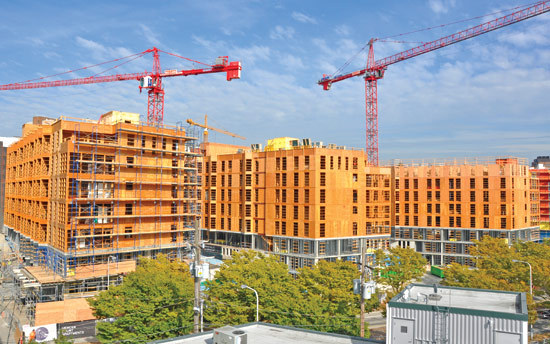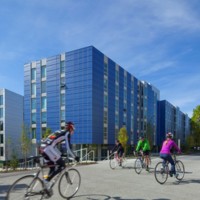As I took in the surroundings while standing in the middle of my block, I felt a sense of calm. My block is removed from the hustle and bustle of the U District. Located at the southern tip, in an area called“Lower Brooklyn” only by city council, it neighbors the University Bridge, Pacific St, and the Burke Gilman trail. Apart from the breeze, the sound of bicyclists and joggers, and the occasional bus, the area is quiet. My block is occupied by a modern mid-rise dorm complex, owned by the University of Washington. These dorms are relatively new, and are filled with students. As the area has been developed, the city and the UW have taken actions to preserve a more“green” feel. They have the UW farm at the southern end of the block, where there are plants grown for use in campus food. Along the pathways are trees, plants, and wood chips. All of these features are nicely contained within an ocean of concrete.
These features are part of UW and city initiatives to make the city more friendly to pedestrians, and to increase a sense of community within the area. As part of this movement, the UW and the city are planning numerous projects. One is to“construct a contiguous waterfront trail extending from Montlake Bridge to University Bridge” (UCUC). This would allow students at the University to see the water that surrounds them by taking a walk. This contrasts with past uses of the waterfront, which included using the areas for docks and businesses along Boat Street. Just recently, in fact, the UWPD offices on the water were closed. The UW also hopes to use city funds to extend the nearby Sakuma Park, which is a small sitting area near the Portage Bay. Neighboring Brooklyn Avenue is also scheduled to be turned into a“green street” wherin potted plants, nicer concrete, and more pedestrian walking area will be added to the streets to increase foot traffic. Additions like these will make the area more popular for pedestrians, and will make the area feel more open, green, and fun.
Many of these efforts are also parter of a much larger effort by the City of Seattle to expand the University District as a neighborhood. They hope to allow many more people— not just students, but families as well— to exist in the area. Since the 1990s, the West Campus of UW has been slowly rezoned to allow for mid-rise buildings. As a result, the Mercer Court apartments were created. They, along with Stevens Court apartment next-door, are meant to be multi-family apartment complexes. These type of re-zonings make the area more accessible to families. As more families live in the area, stronger communities are formed. Before this, the area had been zoned for lower-rise buildings, which gave the area a less city-like feel (Heartland).
Each of the sources that I used had a different outlook on the changes in the area. The University Community Urban Center Association seemed to be a coalition of homeowners and local businesses. They seemed to want the U District to be appealing to homeowners, and to increase visitors. The UD Green Streets article, created by the Seattle Department of Planning and Development, seemed as if they were simply taking lead from the political powers of the neighborhood— homeowners, the University, and the City Council. They simply were following the trends set by other neighborhoods in Seattle which are undergoing renovation, including Belltown and SLU.
The city planners who are planning new renovations seem to be less concerned with the history, and more with the wants of the people. In many of the documents, they described forums where people could express their hopes for the future of the area. Often, it seems like there is no desire to keep any remnants of the past U District.
As the University District makes plans for the future, it should consider the changes that have been brought upon the area in the past. My block is subject to the current trends and patterns in all cities: overpopulation and sometimes a feeling of loss of community. Currently, my block is zoned for multi-family housing. The U District should take a look at trying to preserve a more family-oriented area. Enabling families to live here will enable stronger businesses, more safety, and a happier lifestyle for all. Additionally, planners should keep in mind that one of the major stakeholders in the area— students, are often not represented accurately. Since students are here only temporarily, the UW will play a large part in the plans. Since students make less money than the general population, housing costs should be kept in mind with each and every change. In fact, students should be kept in mind throughout the development of the U District. A large part of the U District’s motive is to satisfy the needs and desires of students. Students would like to be happy in their surroundings, and additions such as new trails, safer streets, cleaner streets, and more regulated business could greatly benefit students.



